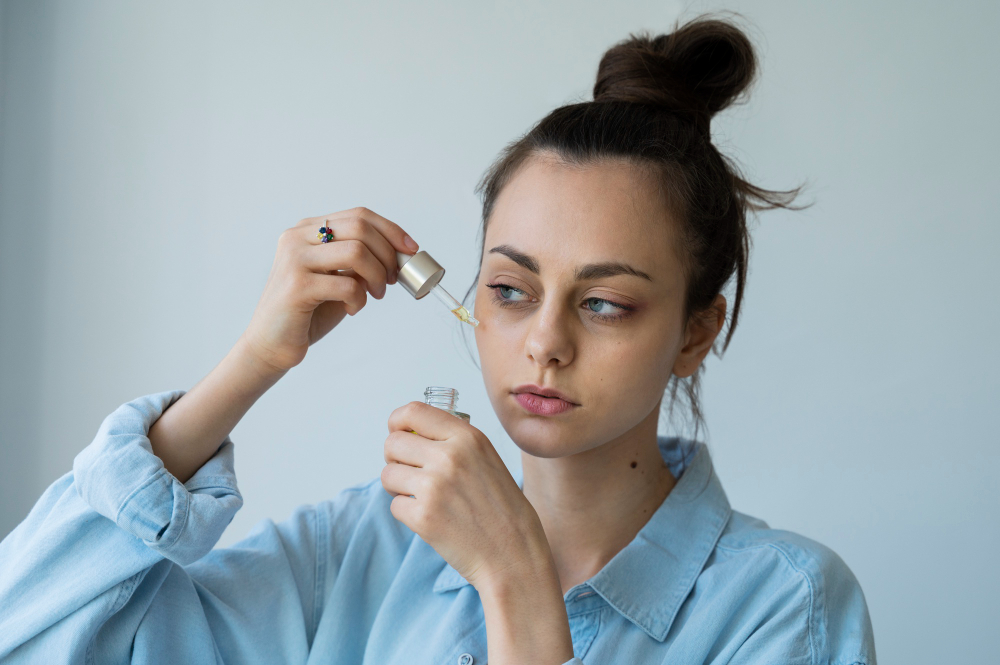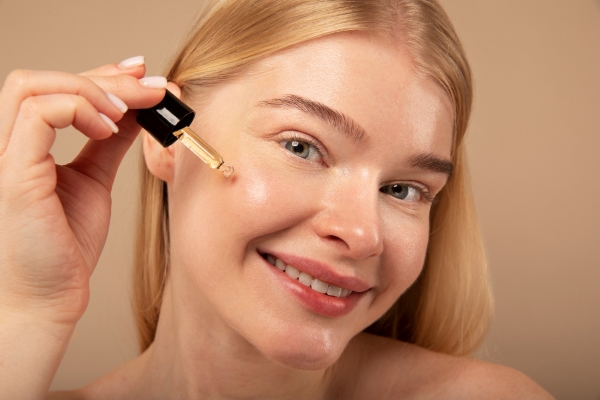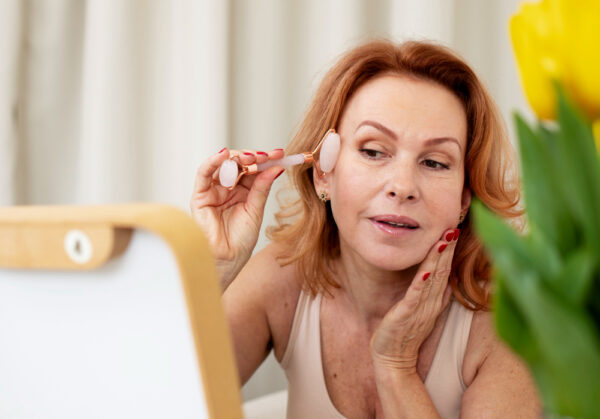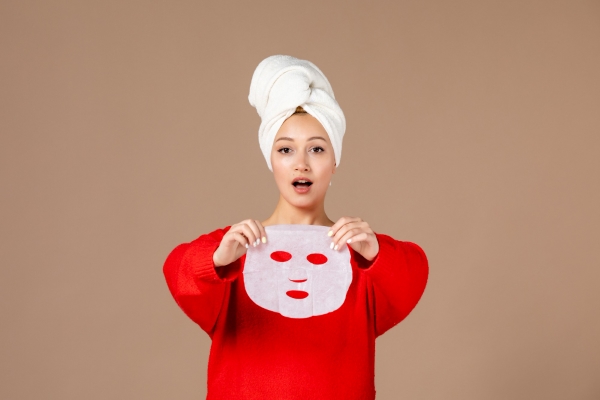If you’ve spent even a little time researching anti-aging skincare, chances are you’ve heard of retinol and hyaluronic acid (HA).. They’re two of the most talked-about ingredients in the beauty industry. But beyond the flashy headlines and viral TikToks, what’s the real science? Do they actually work—or are we just buying into another trend?
Here’s the truth: retinol and hyaluronic acid (HA) are among the most researched, dermatologist-backed ingredients out there. But what makes them remarkable isn’t just how they work alone—it’s how they work together. When combined thoughtfully, they help your skin do what it was always meant to do: renew, protect, and glow.
We love helping you understand the “why” behind the skincare routines that work. At Radiant Skin Project, We’re here to empower people—especially women aged 25–45—who want real, effective solutions backed by science…not sales pitches.
Retinol: A Proven Age‑Defier
Retinol is a derivative of vitamin A that encourages your skin to shed old, dead cells and replace them with fresh ones. Think of it as a gentle drill sergeant—guiding your skin to perform better, regenerate faster, and stay more resilient.
Dermatologists have used retinoids for decades; the first retinoid (tretinoin) was approved by the U.S. Food and Drug Administration as an acne treatment in 1971. Physicians quickly noticed that tretinoin did more than clear pores — it spurred faster turnover of surface skin cells and boosted collagen, improving skin tone and smoothing fine lines and wrinkles.
The American Academy of Dermatology (AAD) notes that products containing retinoids are suitable for people with mild acne, mild pigmentation irregularities and mild fine lines. However, retinoids are potent: they can cause dryness, irritation and increased sun sensitivity. Dermatologists advise starting with the lowest-intensity formula, using it every other night, and gradually increasing frequency. To minimize irritation, the AAD recommends applying retinoids at night, always wearing sunscreen during the day and using a moisturizer
What Does Retinol Do?
- Stimulates collagen production
- Reduces fine lines and wrinkles
- Improves skin tone and texture
- Fades hyperpigmentation and age spots
- Helps manage acne and congestion
What Makes It Unique?
What sets retinol apart is its multi-functional ability. Most ingredients target one or two issues; retinol works on nearly every marker of aging.
Why Some People Avoid It (And How to Fix That)
Retinol has a reputation for causing irritation. Dryness, redness, and flaking are common complaints—especially when used incorrectly.
But Korean-inspired skincare takes a barrier-first approach:
- Microdosed or encapsulated retinol helps release the active slowly
- Blending it with emollients like shea butter or ceramides buffers the harshness
- Using it only at night, 2–3 times a week, builds tolerance gently
Many in our community have eased into retinol using a retinol moisturizing cream paired with calming ingredients.
Hyaluronic Acid: The Ultimate Hydrator
Hyaluronic acid is a naturally occurring sugar molecule found in your skin, joints and eyes. One of its extraordinary features is its capacity to bind water. One gram of HA can hold up to six liters of water—without making your skin greasy.
As we age, HA levels decline. That’s why our skin starts to feel less plump and hydrated.
Benefits of Hyaluronic Acid:
- Replenishes lost hydration
- Plumps fine lines from within
- Strengthens skin barrier
- Improves elasticity
- Soothes redness and irritation
Why It’s a Staple in Korean Beauty
K-beauty is built on the philosophy of hydration-first. Where Western skincare often treats skin after it’s damaged, Korean skincare prevents damage by maintaining hydration from the start.
A good hyaluronic acid serum doesn’t sit on top of your skin. Look for multi-molecular weight formulas that penetrate different layers—offering both surface hydration and deeper support.
Why Use Retinol and Hyaluronic Acid Together?
Here’s where things get interesting. Retinol is a powerful exfoliant. But it can dry out your skin. Hyaluronic acid hydrates like a dream. But it doesn’t fix aging on its own.
Used together, they balance each other out.
| Retinol | Hyaluronic Acid |
| Promotes cell turnover | Binds moisture into fresh cells |
| Can cause dryness | Relieves dryness |
| Increases skin sensitivity | Soothes and calms |
| Boosts collagen | Enhances elasticity |
Dermatologist-Recommended Pairing
Most dermatologists agree: If you’re using retinol, you should use HA.
“Hydration is essential when introducing retinoids,” says Dr. Audrey Kunin, board-certified dermatologist. “HA helps reduce flaking and inflammation, improving tolerance and results.”

Building a Realistic Routine
Let’s face it: Skincare can feel overwhelming. But your routine doesn’t need 12 complicated steps. Here’s a simple beginner-friendly framework that includes both retinol and HA:
AM Routine:
- Cleanser: Gentle, non-foaming
- Toner (optional): Hydrating mist or essence
- Hyaluronic Acid Serum: Pat into damp skin
- Moisturizer: Lightweight, non-comedogenic
- Sunscreen (ALWAYS): SPF 30+
PM Routine:
- Cleanser: Removes makeup and impurities
- Hyaluronic Acid Serum: Again, damp skin = best absorption
- Retinol Cream: Pea-sized amount; avoid eyes and corners of mouth
- Barrier Cream or Oil (optional): Lock in actives overnight
Start slow. Use retinol every third night for the first two weeks. Always apply HA first.
Real-World Stories From Real Skin Journeys
“I used to think I had to choose between anti-aging or hydration. But using both HA and retinol together gave me the softest, clearest skin of my adult life.” – Nisha, 37
“I had tried retinol before, but it made my skin flake and sting. Adding a HA serum first made all the difference. My skin adjusted so much faster.” – Amira, 28
“I travel a lot, so my skin gets stressed. I rely on my HA serum in-flight and my retinol cream at night. That combo keeps my skin consistent.” – Caroline, 42
What to Look For in Each Product
A Great Retinol Formula Should:
- Use encapsulated or time-release retinol
- Be under 0.5% for beginners
- Contain buffers like aloe, panthenol, or jojoba oil
We like formulations that also include vitamin E or niacinamide to reduce sensitivity.
A Great Hyaluronic Acid Serum Should:
- Contain multiple molecular weights of HA
- Be fragrance-free
- Include partners like glycerin, licorice root, or green tea for added benefits
Avoid sticky or heavily perfumed formulas—they often use filler ingredients that don’t help your skin.
Safety, Side Effects, and Smart Use
Can Anyone Use Retinol?
Most people can, with patience. But avoid it if you’re pregnant or have certain skin conditions (check with a dermatologist).
Common Side Effects:
- Dryness or peeling (especially early on)
- Mild redness or tingling
How to Minimize Risk:
- Always apply to dry skin (wet skin absorbs too fast)
- Use HA before and a moisturizer after
- Never skip sunscreen during the day
How About Hyaluronic Acid?
HA is generally very safe. Just make sure to apply it on damp skin and seal it with a moisturizer—otherwise it may draw moisture out of the skin instead of into it.
Why This Combo Aligns With Our Mission
Radiant Skin Project was created to help people understand their skin, not just follow influencers. Our mission is rooted in three core values:
- Education First: We don’t sell. We guide.
- Science-Backed Simplicity: Skincare shouldn’t be a mystery.
- Empowered Wellness: When you understand your routine, you reclaim control.
We also believe in sustainable beauty. Many of the best Korean-inspired skincare formulations focus not just on effectiveness, but also:
- Cruelty-free production
- Eco-conscious packaging
- Minimal fillers, no parabens
By investing in well-formulated retinol and HA products, you also reduce waste by needing fewer items in your routine.
Conclusion:
Retinol and hyaluronic acid aren’t magic bullets. But together, they form one of the smartest, most effective skincare partnerships out there.
If you’ve ever felt overwhelmed, underwhelmed, or just confused by the skincare world, we hope this guide gave you something rare: clarity.
The best part? You don’t need to spend a fortune. You just need:
- A gentle retinol product that works with your skin
- A well-formulated HA serum to support your barrier
- A consistent routine, grounded in care
Explore More, Learn More
We offer ingredient spotlights, expert interviews, and real-world skincare guides at RadiantSkinProject.org. Because your skin deserves more than marketing.
Let this be your first step toward skincare that feels as good as it looks.


